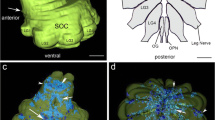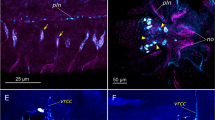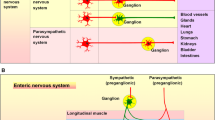Abstract
In the present study, the anatomical association and functional interaction between nerve fibres and granular cells in the atrium of the snail Achatina achatina are investigated using a combination of scanning electron microscopy (SEM), pharmacological and immunofluorescence techniques. The SEM studies support a close anatomical association of axons with granular cells and new features of surface morphology are revealed. Pharmacological experiments showed that both serotonin and FMRFamide were able to induce degranulation of granular cells and the release of cysteine-rich atrial secretory protein. Serotonin- and FMRFamide-immunoreactive nerve fibres were observed at variable distances from granular cells, ranging from close contact to distances as far as the diameter of a muscle bundle. These results suggest that serotonin and FMRFamide play a role as paracrine excitatory transmitters in nerve-to-granular cell communication.






Similar content being viewed by others
References
Akagawa M, Furukawa Y, Kobayashi M (1988) Dual effects of 5-hydroxytryptamine on the heart of a pulmonate, Achatina fulica Férussac. Comp Biochem Physiol C 89:327–331
Amsellem J, Nicaise G (1976) Distribution of the glio-interstitial system in molluscs. Cell Tissue Res 165:171–184
Andrews EB (1976) The fine structire of the heart of some prosobranch and pulmonate snail in relation to filtration. J Molluscan Stud 42:199–216
Andrews EB, Taylor PM (1988) Fine structure, mechanism of heart function and haemodynamics in the prosobranch gastropod molluscLittorina littorea (L.). J Comp Physiol B 158:247–262
Boyd PJ, Osborne NN, Walker RJ (1984) The pharmacological actions of 5-hydroxytryptamine, FMRF-amide and substance P and their possible occurrence in the heart of the snail Helix aspersa L. Neurochem Int 6:633–640
Bystrova OA, Shabelnikov SV, Martynova MG (2014) The process of granule exocytosis in non-stimulated atrial granular cells of the snail, Achatina achatina: An ultrastructural, histochemical and immunocytochemical study. Acta Histochem 116:14–19
Cottrell GA, Osborne N (1969) A neurosecretory system terminating in the Helix heart. Comp Biochem Physiol 28:1455–1459
Dieringer N, Koester J, Weiss KR (1978) Adaptive changes in heart rate of Aplysia californica. J Comp Physiol 123:11–21
Duval A, Runham NW (1981) The arterial system of six species of terrestrial slug. J Molluscan Stud 47:43–52
Elekes K (2000) Ultrastructural aspects of peptidergic modulation in the peripheral nervous system of Helix pomatia. Microsc Res Tech 49:534–546
Elekes K, Ude J (1994) Peripheral connections of FMRFamide-like immunoreactive neurons in the snail, Helix pomatia: an immunogold electron microscopic study. J Neurocytol 23:758–769
Erdelyi L, Halasz N (1972) Electron-microscopical observations on the auricle of snail heart (Helix pomatia L.) with special regard to the structure of granulated cells. Acta Biol Szeged 18:253–267
Fujimoto K, Ohta N, Yoshida M, Kubota I, Muneoka Y, Kobayashi M (1990) A novel cardio-excitatory peptide isolated from the atria of the African giant snail, Achatinafulica. Biochem Biophys Res Commun 167:777–783
Fujimoto k, Kubota I, Yasuda-Kamatani Y, Minakata H, Nomoto K, Yoshida M, Harada A, Muneoka Y, Kobayashi M (1991) Purification of achatin-I from the atria of the African giant snail, Achatina fulica, and its possible function. Biochem Biophys Res Commun 177:847–853
Fujiwara-Sakata M, Kobayashi M (1994) Localization of FMRFamide- and ACEP-1-like immunoreactivities in the nervous system and heart of a pulmonate mollusc, Achatina fulica. Cell Tissue Res 278:451–460
Furukawa Y, Kobayashi M (1987a) Neural control of heart beat in the African giant snail, Achatina fulica Férussac: I. Identification of the heart regulatory neurones. J Exp Biol 129:279–293
Furukawa Y, Kobayashi M (1987b) Neural control of heart beat in the African giant snail, Achatina fulica Ferussac: II Interconnections among the heart regulatory neurones. J Exp Biol 129:295–307
Harris LL, Lesser W, Ono JK (1995) FMRFamide is endogenous to the Aplysia heart. Cell Tissue Res 282:331–341
Haszprunar G, Wanninger A (2012) Molluscs. Curr Biol 22:R510–R514
Hill RB (1987) Cardiovascular control in Mollusca. Experientia 43:953–956
Hill RB, Welsh JH (1966) Heart, circulation, and blood cells. In: Wilbur KM, Yonge CV (eds) Physiology of Mollusca, vol 2. Academic, San Diego, pp 125–174
Hori K, Furukawa Y, Kobayashi M (1990) Regulatory actions of 5-hydroxytryptamine and some neuropeptides on the heart of the African giant snail, Achatina fulica Ferussac: Physiology. Zool Sci 7:377–384
Horsfield GI (1965) The effect of compound 48/80 on the rat mast cell. J Pathol Bacteriol 90:599–605
Jones HD (1983) The circulatory systems of Gastropods and Bivalves. In: Wilbur KM, Saleuddin ASM (eds) The Mollusca, vol 5. Academic Press, San Diego, pp 189–238
Keith IM, Jin J, Saban R (1995) Nerve-mast cell interaction in normal guinea pig urinary bladder. J Comp Neurol 363:28–36
Kodirov SA (2011) The neuronal control of cardiac functions in Molluscs. Comp Biochem Physiol A 160:102–116
Lambracht-Hall M, Konstantinidou AD, Theoharides TC (1990) Serotonin release from rat brain mast cells in vitro. Neuroscience 39:199–207
Lee FO, Cheng TC (1971) Schistosoma mansoni infection in Biomphalaria glabrata: Alterations in heart rate and thermal tolerance in the host. J Invertebr Pathol 18:412–418
Margulis L, Hinkle G (1992) Large symbiotic spyrochetes: Clevelandina, Cristispira, Diplocalyx, Hollandina, and Pillotina. In: Balows A, Trüper HG, Dworkin M, Harder W, Schleifer KH (eds) The Procaryotes. Springer, New York, pp 3965–3978
Martin AW (1983) Excretion. In: Wilbur KM, Saleuddin ASM (eds) The Mollusca, vol 5. Academic Press, San Diego, pp 353–405
Martynova MG (2004) Proliferation and differentiation processes in the heart muscle elements in different phylogenetic groups. International Review of Cytology, vol Volume 235. Academic, San Diego, pp 215-250
Martynova MG, Bystrova OA, Shabelnikov SV, Margulis BA, Prokofjeva DS (2007) Hsp70 in the atrial neuroendocrine units of the snail, Achatina fulica. Cell Biol Int 31:413–419
Muñoz-Chápuli R, Carmona R, Guadix JA, Macías D, Pérez-Pomares JM (2005) The origin of the endothelial cells: an evo-devo approach for the invertebrate/vertebrate transition of the circulatory system. Evol Dev 7:351–358
Nicaise G (1973) The gliointerstitial system of Molluscs. In: Bourne GH, Danielli JF (eds) International Review of Cytology, vol 34. Academic, San Diego, pp 251-332
Plesch B (1977) An ultrastructural study of the musculature of the pond snail Lymnaea stagnalis (L.). Cell Tissue Res 180:317–340
Romero SMB, Hoffmann A (1996) Heart rate and temperature in the snail Megalobulimus sanctipauli: role of the cardiac nerve. Can J Physiol Pharmacol 74:1362–1365
Romero SMB, Hoffmann A (2006) Role of the cardiac nerve in the effect of a novel innocuous stimulus on the heart rate of Megalobulimus mogianensis. Braz J Med Biol Res 39:833–837
Romero SMB, Hoffmann A (2008) Role of the cardiac nerve in the adaptive changes of heart rate in response to an aversive stimulus in Megalobulimus mogianensis. Braz J Med Biol Res 41:432–436
Rozniecki JJ, Dimitriadou V, Lambracht-Hall M, Pang X, Theoharides TC (1999) Morphological and functional demonstration of rat dura mater mast cell–neuron interactions in vitro and in vivo. Brain Res 849:1–15
S.-Rózsa K (1979) Heart regulatory neural network in the central nervous system of Achatina fulica (férussac) (Gastropoda: Pulmonata). Comp Biochem Physiol A 63:435–445
S.-Rózsa K, Zs.-Nagy I (1967) Physiological and histochemical evidence for neuroendocrine regulation of heart activity in the snail Lymnaea stagnalis L. Comp Biochem Physiol 23:373–382
Schmidt G (1916) Blutgefäßsystem und mantelhöhle der weinbergschnecke (Helix pomatia). Z Wiss Zool 115:201–216
Shabelnikov S, Kiselev A (2015) Cysteine-rich strial secretory protein from the snail Achatina achatina: purification and structural characterization. PLoS ONE 10:e0138787
Shabelnikov SV, Bystrova OA, Ivanov VA, Margulis BA, Martynova M (2009) Atrial granular cells of the snail Achatina fulica release proteins into hemolymph after stimulation of the heart nerve. J Exp Biol 212:3211–3220
Sitnikova T, Michel E, Tulupova Y, Khanaev I, Parfenova V, Prozorova L (2012) Spirochetes in gastropods from Lake Baikal and North American freshwaters: new multi-family, multi-habitat host records. Symbiosis 56:103–110
Suzuki R, Furuno T, McKay DM, Wolvers D, Teshima R, Nakanishi M, Bienenstock J (1999) Direct neurite-mast cell communication in vitro occurs via the neuropeptide substance P. J Immunol 163:2410–2415
Suzuki A, Suzuki R, Furuno T, Teshima R, Nakanishi M (2004) N-Cadherin plays a role in the synapse-like structures between mast cells and neurites. Biol Pharm Bull 27:1891–1894
Theoharides TC, Singh LK, Boucher W, Pang X, Letourneau R, Webster E, Chrousos G (1998) Corticotropin-releasing hormone Induces skin mast cell degranulation and increased vascular permeability, a possible explanation for its proinflammatory effects. Endocrinology 139:403–413
Volkmer-Ribeiro C (1970) Enterochromaffin properties of granular cells in the heart of the snails Helix aspersa and Strophocheilus oblongus. Comp Biochem Physiol 37:481–492
Weatherill D, Chase R (2005) Modulation of heart activity during withdrawal reflexes in the snail Helix aspersa. J Comp Physiol A 191:355–362
Wendelaar Bonga SE, Boer HH (1969) Ultrastructure of the reno-pericardial system in the pond snailLymnaea stagnalis (L.). Z Zellforsch Mikrosk Anat 94:513–529
Weragoda RMS, Walters ET (2007) Serotonin induces memory-like, rapamycin-sensitive hyperexcitability in sensory axons of Aplysia that contributes to injury responses. J Neurophysiol 98:1231–1239
Yasuda-Kamatani Y, Kobayashi M, Yasuda A, Fujita T, Minakata H, Nomoto K, Nakamura M, Sakiyama F (1997) A novel d-amino acid-containing peptide, fulyal, coexists with fulicin gene-related peptides in Achatina atria. Peptides 18:347–354
Zhuravlev V, Bugaj V, Kodirov S, Safonova T, Staruschenko A (2001) Giant multimodal heart motoneurons of Achatina fulica: a new cardioregulatory input in pulmonates. Comp Biochem Physiol A 130:183–196
Zhuravlev V, Safonova T, Bugaj V, Kodirov S (2002) Mechanisms of viscerocardial reflexes in land pulmonate mollusc, Achatina fulica F. Zool Polon 47:5–19
Acknowledgments
The author is grateful to Dr. Marina G. Martynova for helpful discussions. The author acknowledges Saint-Petersburg State University (http://eng.spbu.ru) for research grant 1.50.1042.2014 and the Russian Foundation for Basic Research (http://www.rfbr.ru) for research grant 16-04-00069.
Author information
Authors and Affiliations
Corresponding author
Rights and permissions
About this article
Cite this article
Shabelnikov, S. Nerve–granular cell communication in the atrium of the snail Achatina achatina occurs via the cardioexcitatory transmitters serotonin and FMRFamide. Cell Tissue Res 366, 245–254 (2016). https://doi.org/10.1007/s00441-016-2483-x
Received:
Accepted:
Published:
Issue Date:
DOI: https://doi.org/10.1007/s00441-016-2483-x




